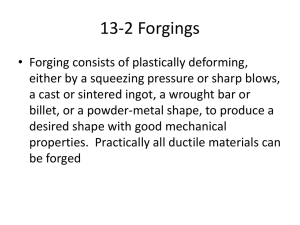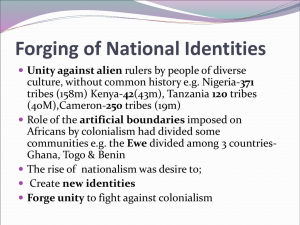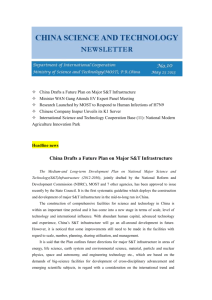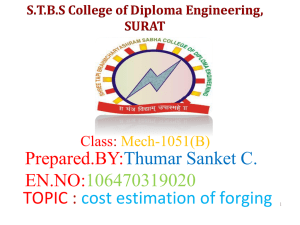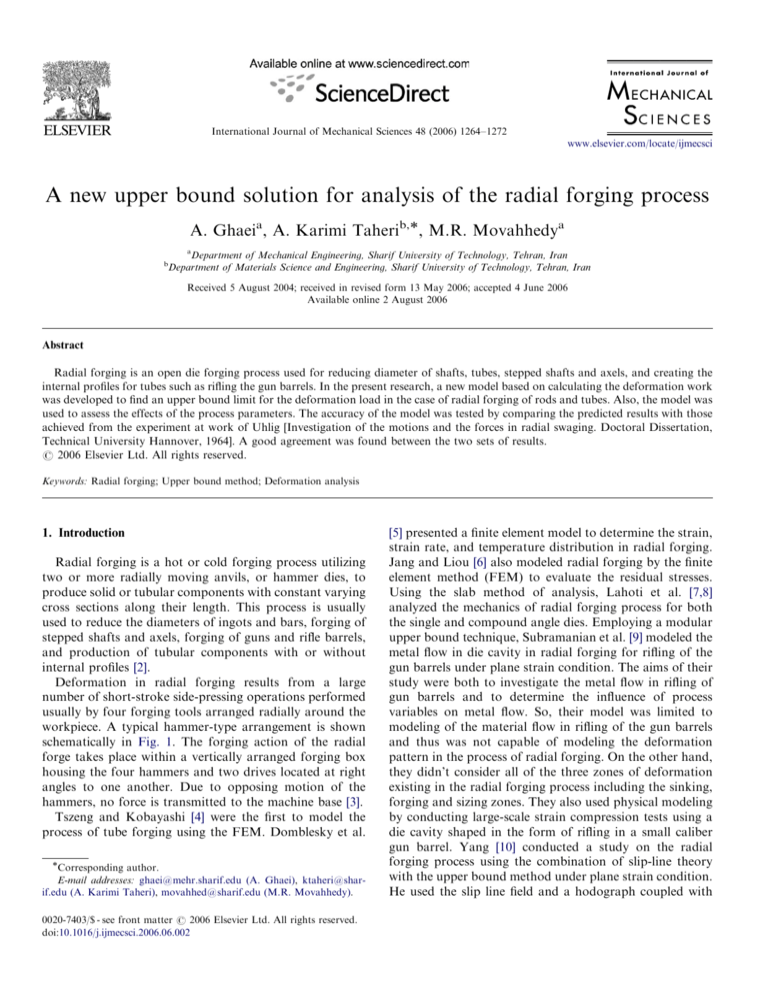
ARTICLE IN PRESS
International Journal of Mechanical Sciences 48 (2006) 1264–1272
www.elsevier.com/locate/ijmecsci
A new upper bound solution for analysis of the radial forging process
A. Ghaeia, A. Karimi Taherib,, M.R. Movahhedya
a
Department of Mechanical Engineering, Sharif University of Technology, Tehran, Iran
Department of Materials Science and Engineering, Sharif University of Technology, Tehran, Iran
b
Received 5 August 2004; received in revised form 13 May 2006; accepted 4 June 2006
Available online 2 August 2006
Abstract
Radial forging is an open die forging process used for reducing diameter of shafts, tubes, stepped shafts and axels, and creating the
internal profiles for tubes such as rifling the gun barrels. In the present research, a new model based on calculating the deformation work
was developed to find an upper bound limit for the deformation load in the case of radial forging of rods and tubes. Also, the model was
used to assess the effects of the process parameters. The accuracy of the model was tested by comparing the predicted results with those
achieved from the experiment at work of Uhlig [Investigation of the motions and the forces in radial swaging. Doctoral Dissertation,
Technical University Hannover, 1964]. A good agreement was found between the two sets of results.
r 2006 Elsevier Ltd. All rights reserved.
Keywords: Radial forging; Upper bound method; Deformation analysis
1. Introduction
Radial forging is a hot or cold forging process utilizing
two or more radially moving anvils, or hammer dies, to
produce solid or tubular components with constant varying
cross sections along their length. This process is usually
used to reduce the diameters of ingots and bars, forging of
stepped shafts and axels, forging of guns and rifle barrels,
and production of tubular components with or without
internal profiles [2].
Deformation in radial forging results from a large
number of short-stroke side-pressing operations performed
usually by four forging tools arranged radially around the
workpiece. A typical hammer-type arrangement is shown
schematically in Fig. 1. The forging action of the radial
forge takes place within a vertically arranged forging box
housing the four hammers and two drives located at right
angles to one another. Due to opposing motion of the
hammers, no force is transmitted to the machine base [3].
Tszeng and Kobayashi [4] were the first to model the
process of tube forging using the FEM. Domblesky et al.
Corresponding author.
E-mail addresses: ghaei@mehr.sharif.edu (A. Ghaei), ktaheri@sharif.edu (A. Karimi Taheri), movahhed@sharif.edu (M.R. Movahhedy).
0020-7403/$ - see front matter r 2006 Elsevier Ltd. All rights reserved.
doi:10.1016/j.ijmecsci.2006.06.002
[5] presented a finite element model to determine the strain,
strain rate, and temperature distribution in radial forging.
Jang and Liou [6] also modeled radial forging by the finite
element method (FEM) to evaluate the residual stresses.
Using the slab method of analysis, Lahoti et al. [7,8]
analyzed the mechanics of radial forging process for both
the single and compound angle dies. Employing a modular
upper bound technique, Subramanian et al. [9] modeled the
metal flow in die cavity in radial forging for rifling of the
gun barrels under plane strain condition. The aims of their
study were both to investigate the metal flow in rifling of
gun barrels and to determine the influence of process
variables on metal flow. So, their model was limited to
modeling of the material flow in rifling of the gun barrels
and thus was not capable of modeling the deformation
pattern in the process of radial forging. On the other hand,
they didn’t consider all of the three zones of deformation
existing in the radial forging process including the sinking,
forging and sizing zones. They also used physical modeling
by conducting large-scale strain compression tests using a
die cavity shaped in the form of rifling in a small caliber
gun barrel. Yang [10] conducted a study on the radial
forging process using the combination of slip-line theory
with the upper bound method under plane strain condition.
He used the slip line field and a hodograph coupled with
ARTICLE IN PRESS
A. Ghaei et al. / International Journal of Mechanical Sciences 48 (2006) 1264–1272
Nomenclature
A
cross-sectional area of the element at the end of
step
As
cross-sectional area of the element at the start
of step
Afric
contact area at die–part interface
As1, As2 shear surfaces (Fig. 6)
e
length of deformation step in the radial
direction (Figs. 4(a) and (b))
Fr
radial force applied to hammer dies
Fsiz
force due to the deformed material in the sizing
zone that applies to the dies
k
yield shear stress of the part
L1
length of the sinking zone
L2
length of the forging zone
L3
length of the sizing zone
m
friction shear factor
R
outer radius of the element
Rm
radius of the mandrel
R0
outer radius of the preform
R1
inner radius of the preform
R2
outer radius of the product
Rs
outer radius of the element at the start of
deformation step
t
thickness of the element at the end of step
1265
ts
t0
V
Wf1
thickness of the element at the start of step
thickness of the preform
the element volume
friction work at the part–die interface in the
sinking zone
Wfm2 friction work at the part–mandrel interface in
the forging zone
Wfm3 friction work at the part–mandrel interface in
the sizing zone
Wfd2
friction work at the part–die interface in the
forging zone
Wfd3
friction work at the part–die interface in the
sizing zone
Ws1, Ws2 shear work over the surfaces As1, As2
Ws3
shear work over the surface adding material to
the sinking zone
Wp1, Wp2 plastic work at the sinking and forging zones,
respectively
Ds
amount of element movement in the direction
of material flow (Figs. 4 and 5)
a
die angle
er
strain in the radial direction
ey
strain in the circumferential direction
ez
strain in the axial direction
¯
effective strain
s̄
flow stress of the material in compression
Fig. 1. Typical tool arrangement in radial forging.
the use of a non-linear optimization technique to find the
field angles and other defining parameters. The results of
his study showed that this procedure provides a powerful
method for calculating the complicated slip-line field
solutions. Thompson et al. [11] presented a steady-state
approximation technique for the analysis of radial forging.
Their approximation was used with the finite element
method to determine the billet temperature and deformation during the forging process.
During the manufacture of tubular products employing
radial forging, the forging pressure, the state of stress and
also the flow pattern are influenced by various parameters
such as reduction in cross-section area, the shape of both
the hammer dies and the mandrel, the frictional conditions
ARTICLE IN PRESS
A. Ghaei et al. / International Journal of Mechanical Sciences 48 (2006) 1264–1272
1266
at the interfaces and the flow properties of the material.
Interactions of some of these parameters with each others
often make it difficult to find an exact mathematical
solution to predict the real phenomenon occurring in the
process. For this reason, approximate methods both
analytical and numerical have been developed.
Up to now, the radial forging process has been modeled
by both the slab and the finite element methods. Although,
simulations based on the FEM method are capable of
predicting many variables in the process such as strain,
strain rate and stress distributions somewhat more
accurately, but to obtain these are often very time
consuming and computationally more expensive. Therefore, simplified methods such as the upper bound method
when applied properly can yield the answers rapidly while
being very effective. To our knowledge, a detailed and
complete analysis of the radial forging process itself, based
on the upper bound analysis has not been presented in the
literature. Thus, the purpose of the study was to estimate
the load applied on the die during the radial forging
process using a new upper bound solution.
In general, an upper bound technique is based on
calculating the required power in the process using a
kinematically admissible velocity field, but in this study a
direct work-based analysis is presented in order to
determine the load applied to the hammers during the
radial forging process itself [12–17].
2. Analysis
The general model of the radial forging process for
tubes, considered in this study, is shown schematically in
Fig. 2. It is assumed that there is no material spreading
between the hammer dies at the end of the blow, thus,
ensuring a two-dimensional material flow. Again, the effect
of material spreading on the plastic work is neglected,
however, the effect of clearance between the hammer dies
on the friction work at the end of the blow is considered. In
general there is a small gap between the mandrel and the
inner surface of the billet. In other words, forging under the
conical portion of the hammer dies is accompanied by a
certain amount of sinking. This sinking causes a longitudinal back-push applied on the billet at the radial plane
where the inner surface of the tube first touches the
I Sinking
II Forging
III Sizing
mandrel. In addition, the hammer dies also contain a
cylindrical sizing zone. Nearly all the deformation occurs in
the conical inlet section, i.e., in the forging zone (II) shown
in Fig. 2. In the sizing zone (III), most of the tube material
is elastically deformed to the yield limit and only a small
amount of plastic deformation takes place. Nevertheless, a
considerable amount of energy, supplied by the dies, is
needed for this operation. Thus, as shown in Fig. 2 there
are three distinct regions of deformation in radial forging
of the tubes: (a) the sinking zone (I); (b) the forging zone
(II); and (c) the sizing zone (III). In the following analysis
of the process, all three zones are considered. It is obvious
that in some cases, such as during finish forging of the
tubes, the sinking zone may be very small and its
contribution to the overall radial forging load may then
be excluded in the final evaluation of the estimates to the
loads [7].
Depending on the inlet cone angle of the hammer die, a
in Fig. 3, and the friction at the tube–die and the
tube–mandrel interfaces, along with axial push and pull
forces, and also length of the die land, the deforming
material may flow relatively either towards the product or
towards the preform or in both of these directions
simultaneously. Thus, in an almost general case, a neutral
plane may exist somewhere, within the deforming tube, as
indicated schematically (N–N) in the section marked II in
Fig. 2. The material being exactly on this neutral plane
(N–N), is only deformed radially and does not flow axially.
On both sides of the neutral plane (N–N), the metal is
deformed both radially as well as axially, thus it flows away
from the neutral plane (N–N) in both directions, i.e. either
towards the preform or the product. Theoretically, the
neutral plane (N–N), could lie in one of the three zones of
deformation. However, it is usually located in the forging
zone in most of the practical conditions, see Ref. [7].
Therefore, it may be an acceptable engineering accuracy to
assume that the neutral plane (N–N), lies in the middle of
the forging zone. The axial feed makes a secondary forging
zone being practically a small zone relative to the other
zones and its contribution to the total work can therefore
be neglected.
The total work required for the process is divided into
three components; (a) the plastic work or strain energy, (b)
α/2
N
1
2
t0
1
N
I
II
2
N
Die
3
3
α
4
III
4
r
Mandrel
R0
z
CL
L1
L2
L3
Fig. 2. Schematic representation of the radial-forging process for tubes.
R1
N
Rm
R2
CL
Fig. 3. Schematic representation of radial forging for tubes and variables.
ARTICLE IN PRESS
A. Ghaei et al. / International Journal of Mechanical Sciences 48 (2006) 1264–1272
the frictional work, and (c) the shear work which is
dissipated when the material flow direction is changed. The
stroke is divided into many small displacements and it is
assumed that the stress and strain is constant throughout
each element in each step and the work is calculated in the
last step of the stroke.
In the present analysis, the total work required for the
process is obtained using the following assumptions:
1. The material is rigid-plastic.
2. Friction at the die-tube and at the mandrel–tube
interfaces produces a constant frictional shear stress
t ¼ mk at these surfaces, where, 0pmp1 and k is the
yield shear stress.
3. The wall thickness of the tube remains constant
throughout the sinking zone.
4. The stress and strain are homogenous in each element.
5. There are no front-pull and back-push forces.
6. The neutral plane (N–N), is at the middle of the forging
zone. So, the material initially existing between the
preform and this plane flows towards the preform, and
the material existing between the part and this plane
flows towards the product.
2.1. Analysis from the middle of the forging zone (N–N), to
the sinking zone (I)
2.1.1. Forging zone
As the radial forging dies strike, the outer radius is
reduced and the material flows axially. The element being
exactly located in the neutral plane (N–N) is thus deformed
only radially. So, this element elongates, as z dz in the axial
direction. To the left, this element then pushes the
neighboring element towards the preform, while the
neighboring element elongates itself too. Thus, the total
amount of movement in the axial direction for each
elemental step is equal to its axial elongation plus the
movement of the previous element viz.
Dsstep ¼ Dsprevious element þ z dz.
(1)
Since the location of each element is known at the start
of each deformation step, and as the amount of axial
movement of the element can be obtained by Eq. (1),
therefore, the radius of the final location of the element is
given by Eq. (2) (see Fig. 4(a) for movement towards the
left of neutral plane (N–N)).
R ¼ Rs e þ Ds tan a.
(2)
The thickness of the each element at the start and end of
deformation step is given by
ts ¼ Rs Rm ,
(3)
t ¼ R Rm .
(4)
Now since, the location of the element is defined, the
strains can be calculated. The radial, average circumfer-
ential and axial strains are respectively given by;
t
,
r ¼ ln
ts
R t=2
y ¼ ln
,
Rs ts =2
z ¼ ðr þ y Þ
while the effective strain is
rffiffiffiffiffiffiffiffiffiffiffiffiffiffiffiffiffiffiffiffiffiffiffiffiffiffiffiffiffiffi
2 2
ð þ 2y þ 2z Þ.
¯ ¼
3 r
1267
(5)
(6)
(7)
(8)
The element volume is given by
dV ¼ pðR2 ðR Rm Þ2 Þ dz.
(9)
The plastic and frictional work for each element at the
tube–mandrel and at the tube–die interfaces are obtained by
W p2 ¼ s̄ ¯ dV ,
(10)
W fm2 ¼ ðm kÞð2pRm dzÞðDsÞ,
Ds
W fd2 ¼ ðm kÞðAfric Þ
.
cos a
(11)
(12)
2.1.2. Sinking zone
Since, it was assumed that thickness of the tube remains
constant in this zone, the material flows along the die
surface, see Fig. 5. As the hammer dies strike, both the
outer and the inner radii of the elements are reduced.
Therefore, the amount of movement of the first element is
equal to movement of the latest element in the forging zone
divided by cos a. The amount of movement of other
elements can then be determined by
z dz
.
(13)
cos a
Radius of the element in the final location R, similar to
that shown in Fig. 4(b), is given by
Dse ¼ Dsprevious element þ
R ¼ ðRs eÞ þ Ds sin a.
(14)
The cross-sectional area of the element at the start and at
the end of each step is, respectively calculated by
As ¼ p t0 ð2Rs t0 cos aÞ,
(15)
A ¼ p t0 ð2R t0 cos aÞ.
(16)
As the variation in wall thickness of the tube in the
sinking zone is disregarded, the radial strain is zero.
Therefore, the incremental strain in the z-direction is equal
to the variation in cross-sectional area of the element:
dA
A
! z ¼ ln
dz ¼ .
(17)
A
As
The effective strain is given by
2
¯ ¼ pffiffiffi z .
3
(18)
ARTICLE IN PRESS
A. Ghaei et al. / International Journal of Mechanical Sciences 48 (2006) 1264–1272
1268
N
N
e
Initial State
ts
t
Final State
Rs
∆s
∆s
R
dz
dz
N
N
CL
CL
(b)
(a)
Fig. 4. The element located in forging zone.
e
tan of element at the final location, see Fig. 4(b), is evaluated
by
R ¼ ðRs eÞ Ds tan a.
Since, both the radii at the initial and the final positions
are known; the strains can be determined using Eqs.
(3)–(8). Similarly, the plastic and frictional works are
determined using Eqs. (10)–(12).
e
∆s
Final
(21)
Initial
Fig. 5. The element located in sinking zone.
The plastic and frictional works for each element can be
determined respectively as
W p1 ¼ s̄ ¯ dV ,
(19)
dz
W f 1 ¼ ðm kÞ Afric
ðDsÞ.
cos a
(20)
2.2. Analysis from the middle of the forging zone to the
sizing zone (III)
2.2.1. Forging zone
Following a similar approach to that presented in
Section 2.1.1, the amount of movement for each element
in the forging zone (II), is determined using Eq. (1). Again,
the initial location of the element is known and the radius
2.2.2. Sizing zone
Neglecting the small portion of plastic deformation in
the sizing zone, the amount of movement in this zone is
equal to the movement of the last element in the forging
zone. The frictional works between the mandrel–tube and
the die–tube interfaces are respectively determined by
e
e W fm3 ¼ ðm kÞð2p Rm L3 Þ Ds þ
,
(22)
sin a tan a
e
e ,
(23)
W fd3 ¼ ðm kÞðAfric Þ Ds þ
sin a tan a
where, Ds as before is obtained from the forging zone.
Again, as mentioned earlier, the material exiting the
sizing zone is deformed and a considerable amount of
energy is required for this operation. The results of FEM
simulations of the process conducted by Ameli [18] also
show that stress in the sizing zone reaches to the yield stress
according to the Von-Mises yield criterion. Therefore, the
contribution of this energy to the overall radial load is of
some importance. As the axial stress (the largest stress) is
ARTICLE IN PRESS
A. Ghaei et al. / International Journal of Mechanical Sciences 48 (2006) 1264–1272
positive and the radial stress (the smallest stress) is
negative, the flow stress is larger than the radial pressure.
Thus, the maximum radial load required to perform such a
deformation may be written as
F siz ¼ 2p R2 L3 s̄.
(24)
Considering the flow pattern depicted in Fig. 6, the
material changes its flow directions both at the start and at
the end of the sinking zone. As shown in Fig. 6, at the end
point the material flows backwards and changes its
direction by shear. However, mechanics of the deformation
at the start point of the sinking zone is rather complicated,
because some material is flowing backwards while, some is
added to the sinking zone due to the axial feed of the
preform. The interaction of these two motions is thus not
exactly clear. Moreover, the tube is certainly bent and this
makes it difficult to calculate the plastic work expenditure
exactly. Neglecting this interaction, shearing occurs while
the dies are striking. As shown schematically in Fig. 6, the
material is flowing backwards and sheared over marked
surfaces As1 and As2. The amount of material passing
through these surfaces is determined by Eqs. (1) and (13),
respectively. Therefore, each shear work is given by
W s1 ¼ k tan ðaÞAs1 Ds,
(25)
W s2 ¼ k tan ða=2ÞAs2 Ds cos ða=2Þ,
(26)
where
p t0 t0 2Rm þ
cos a
cos a
(27)
p t0
ð2R0 t0 Þ.
cosða=2Þ
(28)
and
As2 ¼
Initial
Final
Fig. 7. Schematic representation of adding material from preform to the
sinking zone.
Thus,
2.3. Shear work
As1 ¼
1269
The third shear work due to adding of the material into
the sinking zone (hatched portion shown in Fig. 7) is
given by
e
W s3 ¼ k tanða=2Þp½R20 ðR0 t0 Þ2 .
(29)
tan a
The total work is obtained by adding all of the works
calculated above. The radial load (Fr) applied to the dies is
obtained by dividing the total work by the stroke step.
2
N
As2
As1
Material Flow
Direction
N
Fig. 6. Material flow direction and shear surfaces.
W total ¼ ðW p1 þ W p2 Þ þ ðW f 1 þ W fm2
þ W fd2 þ W fm3 þ W fd3 Þ
þ ðW s1 þ W s2 þ W s3 Þ,
ð30Þ
W total
þ F siz ,
(31)
e
where Fsiz is the radial load applied by sizing zone which
was given earlier in Eq. (24).
Fr ¼
3. Results and discussion
In order to calculate the total radial forging load, the
dimensions of the three zones of deformation were
calculated from both the tool and workpiece geometry.
Each of the three zones was divided into several ringshaped elements. The press stroke was divided into very
small displacements so that the strain and frictional works
can be assumed to be constant at each deformation step.
As the experimental results on loads were not available
for the radial forging of tubes in the present research, the
loads measured earlier by Uhlig [1] for cold swaging of
AISI 1015 steel rounds and those also used by Lahoti and
Altan [7], were used to verify the loads predicted by the
present analysis. Again, as the measured data given in
Ref. [1] was based on cold work, where the work hardening
induces a considerable effect on the flow stress data, an
equivalent stress–strain relationship of the type s̄ ¼ K ¯ n
was assumed for the billet material. Both the factor K and n
value at the room temperature were assumed to be as given
by Altan et al. [2]:
K ¼ 618:14 MPa;
n ¼ 0:1184.
Again, since in the present analysis, the material was
assumed to be rigid-plastic, an average flow stress s̄, for
both the preform and the part was used. According to
above analysis, the amount of each work was calculated for
the final deformation step. The followed approach was
based on predicting a maximum load during the process.
Employing the analysis, the predicted loads for the various
samples (1)–(4) with the initial billet diameter varying as
15.97–13.99 mm, are given in Table 1, where these results
are compared with both the experimental data measured by
Uhlig [1] and the predicted results by Lahoti and Altan
using the slab method analysis in Ref. [7].
According to the results shown in Table 1, the predicted
loads show a reasonably fair to good agreement with
experiments. It is interesting to note that the results of slab
method [7] show a good agreement for samples (1) and (2),
ARTICLE IN PRESS
A. Ghaei et al. / International Journal of Mechanical Sciences 48 (2006) 1264–1272
1270
Table 1
Comparison of predicted loads with experimental results [1]
Sample
number
Billet diameter
(mm)
Product
diameter
(mm)
Length of
forging zone
(mm)
Length of
sizing zone
(mm)
Predicted loada
by slab (KN) Ref.
[7]
Predicted
maximum loada
(KN)
Loada from
experiment (KN)
Ref. [1]
1
2
3
4
15.97
15.97
15.03
13.99
13.18
13.25
13.11
13.03
18.55
18.09
12.77
6.38
18.00
18.00
18.00
18.00
171.98
170.62
143.37
106.18
193.22
190.42
149.79
105.79
172.00
167.00
124.00
74.50
m ¼ 0.15, a ¼ 4.31, axial feed ¼ 0.37 mm/stroke.
a
Per hammer.
18
500
16
450
m=0.05
m=0.1
m=0.3
14
2
400
1
350
Radial Load, KN
Radial Load, MN
12
10
8
300
250
200
150
6
100
4
50
2
0
0
0
0
5
10
Die Angle, Degree
15
20
0.03
0.06
0.09
0.12
Hammer Displacement, mm
0.15
Fig. 8. The effect of die angle on the radial load per tool (R0 ¼ 20 mm,
R1 ¼ 16 mm, R2 ¼ 13 mm, Rm ¼ 10 mm, m ¼ 0.1).
Fig. 9. The radial load per tool versus hammer displacement
(R0 ¼ 20 mm, R1 ¼ 16 mm, R2 ¼ 13 mm, Rm ¼ 10 mm, m ¼ 0.1, a ¼ 81,
axial feed ¼ 1 mm/stroke).
where the length of forging zone and sizing zone are nearly
equal. However, the predicted loads are higher when the
forging zone is much smaller than the sizing zone which is
the case in the finishing forging, see samples (3) and (4) in
Table 1. According to Lahoti and Altan [7], this
discrepancy may be attributed to the possibility of a lower
friction in the sizing zone. It is interesting to note that the
predicted load by the present approach is not so larger than
predicted load by slab method during finish forging and it
is even smaller in sample (4).
To verify the potential of the model for predicting the
effects of process parameters, a further theoretical analysis
was performed assuming that the material was AISI 1015
and the length of the sizing zone was equal to 18 mm. The
results of this analysis are presented in various Figs. 8–11.
The effect of variation of die angle on the maximum
radial load is plotted in Fig. 8. This figure reveals as the die
angle increases, the radial load decreases because within a
constant reduction in area, the length of contact and thus
the frictional work decreases. Moreover, when the die angle
increases, the radial component of die normal force reduces
and the axial component increases. Therefore, one may
conclude that there is a limitation to increasing the die
angle, because if the die angle increases excessively, the
axial load becomes so large that it may make the preform
to either buckle or throw the part away from the forging
box. Thus as the axial force is known, one can easily
determine whether the part will buckle or not. Also, it is
possible to predict the magnitude of the least required
back-push force that prevents slipping of the part away.
This force can also be used to find the maximum die angle
within a certain process condition such as the reduction in
area, and the length of preform, etc.
Variation of the radial load during the radial movement
of the hammer die, since the hammer die touches the tube
until it reaches to the end of stroke, is plotted in Fig. 9. As
ARTICLE IN PRESS
A. Ghaei et al. / International Journal of Mechanical Sciences 48 (2006) 1264–1272
5000
α=4
α=8
α=20
4500
4000
Radial Load, KN
3500
3000
2500
2000
1500
1000
500
0
0
0.2
0.4
0.6
0.8
1
1271
Fig. 11 shows the effect of reduction in cross-sectional
area of the tube on the radial load at the end of the stroke.
In each case as it is observed, when the reduction is
increased, the maximum required radial load also increases
due to increase in all the work components, i.e. plastic,
frictional and the shear work. It has been reported in
reference [19] that in order to enjoy the benefits of the
radial forging process, the reduction must be so large that
the plastic deformation penetrates to the core of the
material. Thus it is important to choose either a machine
with enough capacity to forge the desired part in one pass
or finding the minimum number of passes when it is not
possible to forge the part in one pass. After calculating the
maximum load, the maximum required rate of work can be
obtained by multiplying the hammers speed by the
maximum load. Obviously, if the calculated power is less
than the machine power, the part can be produced in one
pass. Otherwise, the part should be produced in more than
one pass so that the power of each pass is less than the
machine power.
m
Fig. 10. The effect of m on the radial load per tool (R0 ¼ 16 mm,
R1 ¼ 12 mm, R2 ¼ 10 mm, Rm ¼ 8 mm, a ¼ 41).
In this research, a new approach based on calculating the
work at various stages of the radial-forging process was
presented to predict the maximum load required to deform
the circular billet incrementally. For verification of the
model, the load was predicted for cold forging of the rods,
and then compared with those of the published experimental results of another author, see Ref. [1]. Also, the
effect of various process parameters was assessed by the
model and compared with the published results. A
reasonably good agreement was found between the various
sets of results.
3500
m=0.1
3000
m=0.3
m=0.6
Radial Load, KN
2500
4. Conclusions
2000
1500
1000
Acknowledgments
500
0
0
20
40
60
Reduction in Area, %
80
100
Fig. 11. The effect of reduction in area on the radial load per tool
(R0 ¼ 20 mm, R1 ¼ 16 mm, m ¼ 0.1, a ¼ 81).
may be seen, after the hammer die touches the tube, the
radial load gradually increases almost until the end of the
stroke. At point marked (1) in Fig. 9, where the die land or
sizing zone (III) touches the part, the radial load suddenly
increases and then reaches its maximum value at the end of
the stroke; see point (2) in Fig. 9.
Fig. 10 shows the effect of frictional shear factor m on
the radial forging load at the end of the stroke. It is
observed that when the frictional shear factor m increases,
the radial load also increases due to the increase in
frictional work.
The authors would like to acknowledge with gratitude
for the financial support given to the project by the
Research Board of Sharif University of Technology.
References
[1] Uhlig A, Investigation of the motions and the forces in radial
swaging. Doctoral dissertation, Technical University Hannover,
1964.
[2] Altan T, Oh SI, Gegel H. Metal forming fundamentals and
applications. Materials Park, OH: American Society for Metals;
1983. p. 17.
[3] GFM Precision Forging Machine, GFM Technical literature.
October 1976.
[4] Tszeng TC, Kobayashi S. Determination of residual stresses in radial
forging. Manufacturing Processes Simulation 1986;PED-20:31–45.
[5] Domblesky JP, Shivpuri R, Painter B. Application of finite-element
method to the radial forging of large diameter tubes. Journal of
Material Processing Technology 1995;49:57–74.
[6] Jang DY, Liou JH. Study of stress development in axi-symmetric
products processed by radial forging using a 3-D finite-element
method. Journal of Material Processing Technology 1998;74:74–82.
ARTICLE IN PRESS
1272
A. Ghaei et al. / International Journal of Mechanical Sciences 48 (2006) 1264–1272
[7] Lahoti GD, Altan T. Analysis of the radial forging process for
manufacturing of rods and tubes. Journal of Engineering for Industry
1976;98:265–71.
[8] Lahoti GD, Dembowski PV, Altan T. Radial forging of tubes and
rods with compound-angle dies. In: Proceedings of NAMRC-IV,
Columbus, OH. May 17–19 1976. p. 87–93.
[9] Subramanian TL, Venkateshwar R, Lahoti GD, Lee FM. Experimental and computer modeling of die cavity fill in radial forging of
rifling. Process modeling—fundamentals and applications to metals.
In: Proceedings of process modeling sessions, 1978 and 1979, USA.
[10] Yang S. Research into GFM forging machine. Journal of Material
Processing Technology 1991;28:307–19.
[11] Thompson EG, Hamzeh O, Jackman LA, Srivatsa SK. A quasisteady-state analysis for radial forging. Journal of Material Processing Technology 1992;34:1–8.
[14] Johnson W, Mellor PB. Engineering plasticity. Ellis Harwood
Limited; 1983.
[15] Hosford WF, Caddell RM. Metal forming. Englewood Cliff, NJ:
Prentice-Hall; 1993.
[16] Hung-Hsiou H. A study on precision forging of spur gear forms and
splines by the upper bound method. International Journal of
Mechanical Science 2002;44:1543–58.
[17] Chitkara NR, Aleem A. Extrusion of axi-symmetric bi-metallic tubes
from solid circular billets: application of a generalized upper bound
analysis and some experiments. International Journal of Mechanical
Science 2001;43:2833–56.
[18] Bourkine SP, Babailov NA, Loginov YN, Shimov VV. Energy
analysis of a through-put radial forging machine. Journal of Material
Processing Technology 1999;86:291–9.
[19] Rauschnabel E, Schmidt V. Modern application of radial forging and
swaging in automotive industry. Journal of Material Processing
Technology 1992;35:371–83.
[12] Ameli A. Finite element simulation of the radial forging
process. M.Sc. thesis, Sharif University of Technology, Tehran,
2004.
[13] Lahoti GD, Liuzzi L, Altan T. Design of dies for radial forging of
rods and tubes. Journal of Mechanical Working Technology
1977;1(1):99.

